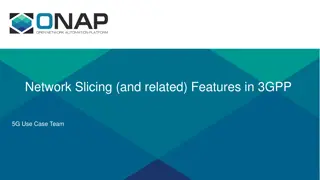Exploring Network Slicing in Future 5G Networks
"The research delves into the design of a 5G-ready architecture known as NFV-based Network Store, aiming to serve as a digital distribution platform for 5G applications. By focusing on network slicing and programmability, the architecture enhances resource efficiency and agility in deploying software components. Addressing current network limitations, the study emphasizes the shift towards virtualization, software-defined networking, and network function virtualization for improved scalability and reliability in future 5G networks."
Download Presentation

Please find below an Image/Link to download the presentation.
The content on the website is provided AS IS for your information and personal use only. It may not be sold, licensed, or shared on other websites without obtaining consent from the author. Download presentation by click this link. If you encounter any issues during the download, it is possible that the publisher has removed the file from their server.
E N D
Presentation Transcript
Network Store: Exploring Slicing Network Store: Exploring Slicing in Future 5G Networks in Future 5G Networks Navid Nikaein, Eryk Schillerx, Romain Favraud, Kostas Katsalis, Donatos Stavropoulos, Islam Alyafawix, Zhongliang Zhaox, Torsten Braunx, and Thanasis Korakis EURECOM, University of Bern ACM MobiArch 15
Motivation 5G technologies aim to provide 1. End-to-end infrastructure that will include all aspects of the network 2. Provisioning processing power on-demand Key enabler Network Abstraction => (Software-Define Networking) Virtualization => (Network function virtualization)
Problem of current cellular networks Does not fit the cloud concept in terms of scalability and reliability Strong coupling between control and data planes State-full design Dependency to dedicated hardware (expensive)
Introduction Design of a 5G-ready architecture NFV-based Network Store that can serve as a digital distribution platform for 5G application use-cases provide programmable pieces of code that on-the-fly reserve required resources deploy and run the necessary software components Configure and program network elements according to the SDN and NFV Provide the end-user with a 5G slice that perfectly matches the demands
Network Store Service-oriented network architecture Programmable and extensible in terms of infrastructure, network services, and applications Network slicing to operate virtual networks on top of physical infrastructures, with virtual resource isolation and virtual network performance guaranties.
Slicing-Enabled 5G Architecture Business Layer: creates the slice that encodes all the details required to deploy the service bundle Service layer supports the creation, and configuration of the service bundle Infrastructure layer supports the real-time reconfigurable cloud ecosystem and virtualization
Infrastructure Layer Programmable Computing, Network and Storage Hardware maximize the infrastructure utilization => dynamically and freely relocate hardware resources on demand NFV enables for extreme flexibility when it comes to the micro-service leverage SDN technologies and programmable data plane technologies to support advanced programmability E.g. JUJU Charm framework that model, build and scale each service bundle on any cloud Metal As a Service (MAAS) are able to program physical severs Enabler for programmable cloud
Infrastructure Layer Programmable RF Hardware RRH can be equipped with the Field Programmable Radio Frequency (FPRF) technology (e.g., FPGA-based Myriad-RF) to allow for RAN programmability Radio Fronthual Archi. Ethernet-based fronthaul network will significantly simplify and lower the price of the cloud network infrastructure for telecommunications
Service and Business Layer Business layer provides functionalities for both the infrastructure and business layers through a Network Store Network Function Store: VNF programming (such as virtual eNB, EPC, HSS of the LTE network) Network Application Store: Provide a feature-rich service (Localization services, Caching application) *Depending on the timing requirements, they can be placed either close to (particular) VNFs at the edge cloud or close to other VNA at the centralized cloud.
LTE as Service(LTEaaS) - Prototype Portable OpenStack-based data center, with a specific configuration that satisfies the needs of deadline critical applications Intel Linux (Ubuntu), low-latency 3.17 OpenStack with Heat to manage the entire life-cycle of a virtual infrastructure and applications LTEaaS slice using a single Heat orchestration Template Specifies the LTE network elements initial parameters Networking requirement
LTE eNB requirements OpenStack to use LXC as its virtualization technology to achieve a near bare metal performance In LTE-FDD, the total RX (UL) + TX (DL) processing should take less than 3 ms to comply with HARQ deadlines Processing load is mainly dominated by uplink and increases with growing PRBs and MCSs
Provisioning of LTE eNB OAI platform on LXC 50 PRBs => 10 Mb/s Only 4 uplink sub-frames (SFs) are granted by the eNB two Linux OS schedulers are used, namely SCHED FIFO and SCHED DEADLINE Dongle as UE Using iPerf
Results OS is not loaded
Loaded 0.6% of lost SFs caused by the scheduler not meeting the deadlines
Conclusion Slice-based 5G architecture NFV, SDN, and cloud-computing to efficiently manages network slices Network Store in a programmable cloud allowing for dynamic network slicing.























